Summary
A few animal groups, including The Humane League, are running ads on Facebook pointing to videos of factory farming and encouraging viewers to go veg. Based on survey data for reduced meat consumption after seeing the videos, I estimate that each $1 donated toward The Humane League's veg ads prevents ~120 days of suffering on factory farms and 20 additional fish deaths. These numbers should not be taken at face value for various reasons, and they mainly serve to help motivate us because of their concreteness. My best conjecture is that the actual effectiveness of veg ads may be one or two orders of magnitude less than what these calculations would suggest. Also, a more careful analysis of the impacts of animal charity would include many more factors.
Note: The study and data in this piece are old and not the latest research. For state-of-the-art calculations on the effectiveness of veg outreach (either by leaflets or ads), see the work of Animal Charity Evaluators, including this blog post.
Contents
Introduction
In 2005-2006, I wrote a piece called "How Much Is a Dollar Worth? The Case of Vegan Outreach" in which I approximated the number of years of factory-farmed suffering prevented per dollar of donations to Vegan Outreach to print veg brochures. Friends have recently pointed me to another way to promote vegetarianism (and general concern for animal suffering)—namely, Facebook ads. One series of ads being run now sends those who click on it to the Who's Against Animal Cruelty? page, which includes a powerful video and Facebook comments below. Because ads of this type don't incur the printing and distribution costs of paper leaflets, they may be even more cost-effective than physical brochures. That said, ordinary Vegan-Outreach-style brochures are still wildly efficient, so I don't want to downplay their value.
Benefits over paper leaflets
Lower opportunity cost.
One oversight in my original "How Much Is a Dollar Worth?" piece was in the calculation of b, the number of booklets distributed per dollar. While it's true that if you divide the number of Vegan Outreach brochures distributed by the organization's budget for the same time period, you get something like 4.7 booklets per dollar, this ignores two factors:
- some of the brochures were handed out by paid leafleters of other organizations, and
- even the volunteer leafleters could have been doing other things with their time (including, if nothing else, making money to donate).
Now, some of those volunteers, if they hadn't been handing out Even If You Like Meat pamphlets, would have been protesting zoos or doing something else of low (negative?) value. But others would have done very effective organizing in some different way. In contrast, online ads have essentially no distribution cost or activist opportunity cost.
(Well, actually, in practice, it can be good to have some volunteers participate on the landing page for the ads, in order to clean up spam, answer questions, correct misinformation, and provide social support to those considering becoming vegetarian. Even a simple, five-second "Like" on a comment can provide encouragement that—every once in a great while—will be the straw that breaks the back of meat-eating.)
Similar or cheaper price per view.
Even ignoring distribution costs, ads may also be cheaper in terms of raw cost per item. According to "How Much Is a Dollar Worth?", page 4, booklets cost 13-20 cents each to print and ship. "Who's Against Animal Cruelty?" ads cost 10-20 cents per click in the US but can go as low as ~2 cents for Latin America, China, etc. Currently, ads in Western countries are more important because (1) those countries eat more meat and (2) the viewers of the ads have more wealth that they might donate to veg causes like this one once they learn about the issue. Also, (3) because I care about veg outreach primarily in order to inspire eventual concern for wild animals among those who shape humanity's future, it's most important to influence the views of those who live in the most powerful countries. All of that said, it seems dubious that ads in less wealthy nations are 5 times less valuable than those in the US.
Survey data
Nick Cooney did a survey on ads linking to a similar website called "The Hidden Face of Food" in fall 2011. Take a look at the results. I'm a bit skeptical of the high reduction in meat consumption among family/friends (which are more than the reductions in meat consumption by those who originally clicked on the ads), but even if we completely ignore those numbers, then we get something like 917 new vegetarians + 1339 meat reducers among the "liked" group and 238 new vegetarians + 300 meat reducers among the "vegetarian starter kit" group. The entire campaign to create these changes took $5,000, although Nick informs me that costs have increased slightly, such that this would now be about $6,000. Let's ignore the meat reducers for simplicity and conservatism. Then, naïvely dividing, we have ($6000)/(917+238) = $5.19 to create a new vegetarian.
There's a big caveat here, which is response bias: Those who answered the survey almost certainly had better news to report than those who didn't. Nick thinks the response rate may have been around 10% of people asked. Further, let's suppose that no one who didn't respond was affected. Then we'd have $5.19/(0.1), which equals a conservative maximum cost of $52 per new vegetarian. Of course, Nick told me:
keep in mind we did offer a tangible item (movie tickets, or rather a high chance of winning them) in exchange for answers, which should have decreased response bias significantly. Also keep in mind that these surveys only represent 8.5% of people who visited the site - those who "liked" the page or ordered a veg starter kit, so calculations of per-dollar effectiveness based on this data and those metrics are ignoring the bit of behavior change produced by all those 91.5% who did not like the page or order a veg kit.
Unfortunately, we don't know how long these people remained veg, or whether/how soon they would otherwise have gone veg from different influences. That said, as I argue in "Appendix: 100-Yard-Line Model," whether people would have otherwise gone veg is not a major problem because there should be further people who were affected, didn't go veg, but later will go veg due to subsequent influences. Finally, I've been ignoring all kinds of other positive spillover effects, like impact on friends, later involvement with animal activism, and donations toward veg-outreach causes.
Nick's survey also shows changes in consumption broken down by type of animal product. I was heartened to see that the fraction of people who increased consumption of fish/chicken/eggs was small (2-5%) compared with the fraction that decreased consumption (72-92%). Because fish and poultry products cause orders of magnitude more suffering per kilogram than beef and dairy, I find it unfortunate that people often say, "I'm not completely vegetarian, but at least I've stopped eating red meat." I'm glad that this trend wasn't particularly prevalent among the "Hidden Face of Food" viewers.
Nick's piece
Nick has a great summary of Facebook veg ads similar to mine. Nick says, "As a full-time animal advocate with over a decade of experience in promoting veg eating, I simply do not see anything else that gives us as much bang for our buck right now in creating new vegetarians and meat-reducers as well-executed Facebook ads." He also gives advice to those conducting the campaigns on how to optimize landing-page display, Facebook-plugin functionality, and target demographics. I particularly like the idea of "flighting" different ads to see which work best. In an email to me, Nick recalls that
one of the many ads we tested in Dec [2011] cost $150 per [veg starter kit] VSK order (!); the good ones cost around $15-25.), and because it's really hard to predict which will work (it doesn't break down cleanly around demographic lines), doing that checking is so very very vital.
Sampling bias and other considerations
Jeff Kaufman wrote two excellent reviews of Nick's survey, highlighting sources of bias in the survey results and clarifying other points of research methodology.
How to donate.
The Humane League is currently running veg ads using grant funds, but if you donate to the organization and ask for the money to go toward veg ads, The Humane League will increase the veg-ads budget without reshuffling other funds elsewhere.
How much is a dollar of veg ads worth?
There are two big problems I have with the estimates in the original "How Much Is a Dollar Worth?" piece:
- The estimates of how long people stay veg are probably too high, and
- the cost per booklet doesn't account for opportunity costs of time for the leafleters.
With veg ads, point #2 is obviated, since ads have very low human cost (maybe a few hours per month) and almost zero marginal human cost. As far as point #1, Nick Cooney has come across some research on veg recidivism showing the following distribution for how long a "new vegetarian" stays veg:
| Percentage | Years staying veg | My point estimate for years staying veg |
| 34% | less than 3 years | 1 year |
| 34% | 3 to 5 years | 4 years |
| 12% | 6 to 10 years | 8 years |
| 20% | more than 10 years | 10 years (just to be very conservative) |
On average, then, a new vegetarian stays veg for (0.34)(1) + (0.34)(4) + (0.12)(8) + (0.2)(10) = 4.7 years. These figures may be understatements, because even when these people go back to eating meat, they eat less than a typical omnivore. That said, veg converts might have started out eating less than a typical omnivore too, especially since many veg converts are female, who tend to eat less meat and less overall. Also note that these statistics on how long people stay veg are for the general population, including people who go veg for health or environmental reasons, not just animal-welfare reasons. But it seems that people who go veg out of concern for animal suffering are less likely to backslide.
If we combine this with the conservative $52 per new vegetarian figure for Humane League veg ads, then we get $52/4.7 = $11 per vegetarian-year. (Jeff Kaufman estimated that Vegan Outreach may create a vegetarian-year for between $4.29 to $536. I don't think Jeff's estimate can be directly compared with my $11 estimate here because the approaches are so different, but at least it seems the orders of magnitude aren't way off.)
To see what this means in terms of animal suffering, we can use the expression amlm + feaele from "How Much Is a Dollar Worth?" Taking the average of the lower and upper bounds of the parameters, this equals (26.5)(49) + (0.25)(253)(1.04) = 1400 days of suffering prevented per year of being veg. At $11 per veg-year, this is a conservative 123 days of suffering prevented per dollar, or more than 1 day of suffering prevented per penny! This is very close to the original lower bound in "How Much Is a Dollar Worth?"
The above figures don't count seafood, which on a per-animal basis comprises most of the animals that people eat. It's tricky to compute days of suffering for fish, because wild-caught fish don't live in factory farms. (Conditions for farmed fish aren't pleasant.) Of course, the pain of slaughter is still very intense, especially since there are no requirements for stunning or humane slaughter of fish. A vegetarian saves more than 225 fish per year, so at $11 per veg-year, this is 20 fish not killed per dollar (in addition to 123 days of suffering prevented for the same dollar).
Finally, these figures ignore the "return on investment" effects of veg ads: Namely, that by creating more vegetarians concerned about animal suffering, we create more people who will become animal advocates and more future donors to groups like The Humane League. I also haven't counted the fact that a society which cares more about animal suffering is more likely eventually to extend that concern to animals in the wild once the technology becomes available. Given the vast number of wild animals—and the potential to create massive amounts more suffering if we spread wild-animal life into the galaxy—I believe that the effect veg ads have on spreading a culture of concern for animals is many times more valuable in expectation than the factory-farmed suffering they avert directly.
Why we shouldn't take these figures at face value
- Elasticities. When people buy less meat, prices decrease somewhat, which induces other consumers to buy more. This price effect is rather small, though. According to Bailey Norwood's figures, refraining from purchase of 1 pound of animal products typically implies an equilibrium reduction of roughly 0.6-0.8 on the production side. The estimates in this piece could thus be multiplied by some factor around 0.6 to 0.8.
- Optimizer's curse. The results described here are based on a single study, which had some methodological problems. If the results seem impressive, that might be because we got lucky with this study and/or because of design flaws. Since I originally wrote this piece, The Humane League and Animal Charity Evaluators have conducted follow-up studies that aim to improve the quality of results. I direct readers to them for the state of the art in this field.
- Outside view. Behavior change is typically expensive to buy. For instance, Carl Shulman estimated an average cost of $50 to $500 to convince someone to vote in an election. A friend of mine estimated that it takes almost $1000 for Planned Parenthood (PP) to avert one unwanted pregnancy, based on PP's budget, the fraction of its budget that goes to contraception, and PP's estimate for the number of pregnancies it averts. So $11 per vegetarian-year sounds suspiciously optimistic.
- Metric is insufficient. The metric of animal-years prevented per dollar serves mainly to move our emotions with its concreteness, but it's definitely not the right bottom line for animal charity. What matters most is promoting a culture of concern for animal suffering in general, in all its forms, such that people may in the future care about even cruelties in nature. Animal-years prevented is only a crude proxy for this. For instance, suppose health arguments are more effective per dollar at creating veg*ans but less effective at promoting concern for animals. Then this metric would optimize for the wrong outreach strategy. More broadly, there are many interventions that may have massive long-term impact for animals that aren't so easily quantified on this "value per dollar" kind of metric.
Here's a quick-and-dirty way to evaluate the plausibility of a figure like $11 per vegetarian-year, inspired by Jeff's approach. Say there are ~107 veg*ans or significant reducetarians (people eating less meat) in the US, and say the annual budget of all veg-outreach activities by all animal organizations is also ~$107 per year. (This cost figure may be conservative insofar as it ignores the opportunity costs of dozens of veg-organization employees and thousands of veg activists who work at low wages for the cause relative to what they could earn and donate by working in the private sector.) Conservatively, I'd guess that veg outreach is responsible for at least 1% of all veg*ans. So the cost per veg*an-year is ~$100. Maybe this estimate is slightly too conservative, but I would guess the true number is closer to $100 than to the $11 estimated in this piece. I don't think 1% is a very low estimate because many people go veg*an for health, environmental, religious, taste, or personal reasons, and most who go veg for animal reasons do so based on books, documentaries, social influence, or their own logical reasoning—not veg ads or pamphlets. Also, it's plausible that the marginal dollar donated toward veg outreach accomplishes less than the average impact of dollars already being spent on veg outreach, since a lot of people have already heard the veg message at least once, and the most receptive audiences are already being targeted.
Example feedback
Below are a few selected viewer responses to veg-ad videos, all from Dec. 2011. These were sent to me by someone else, and I removed names and pictures from the comments.
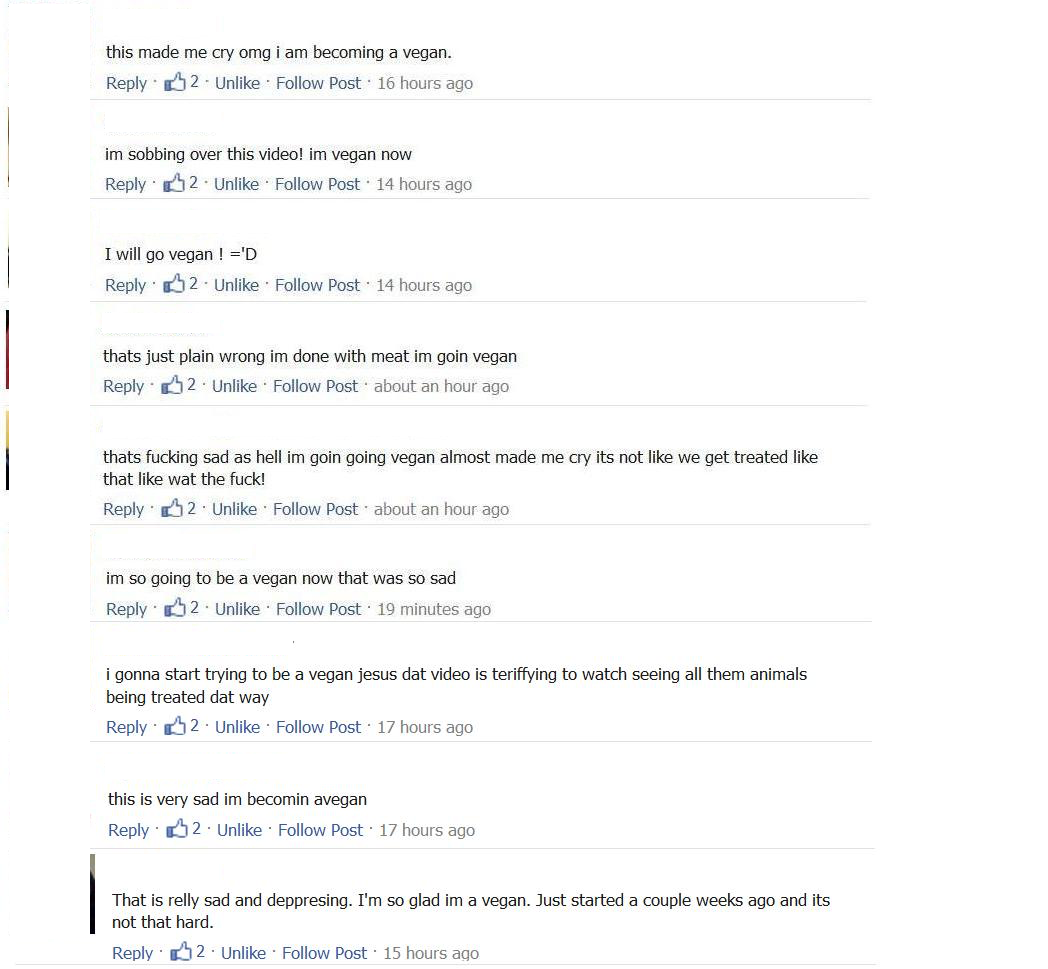
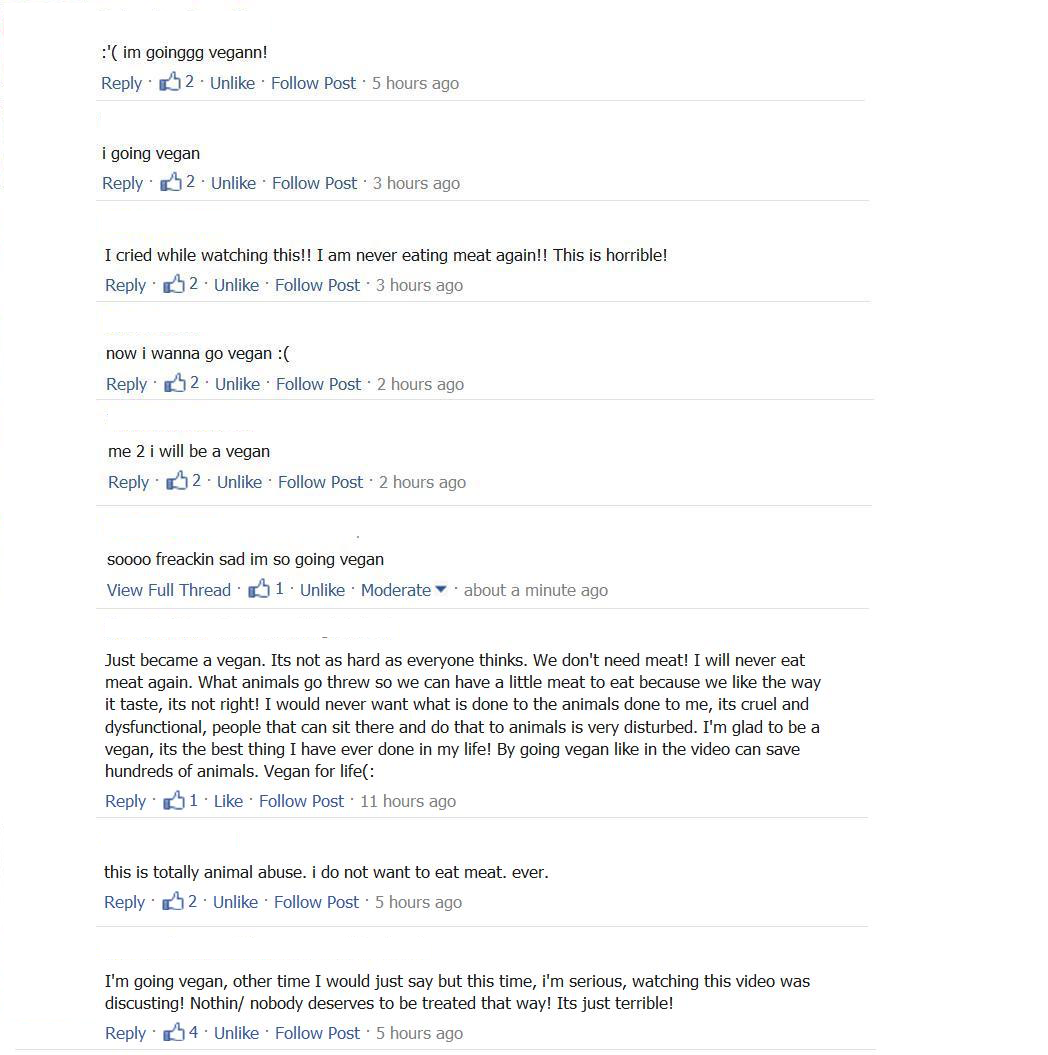
Sample Vegan Outreach ads
Here are some sample ads leading to the landing page, from a Vegan Outreach campaign during summer 2012. (Note: The updated ads do not contain "veganoutreach.org" underneath the title, which should help avoid scaring away those who aren't already sympathetic.)




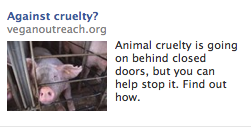
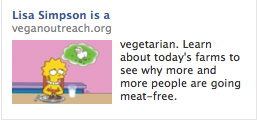
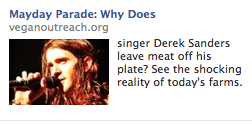
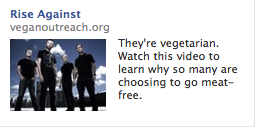
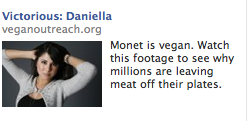
Appendix: 100-Yard-Line Model
Summary: Naive estimators of veg conversion are roughly unbiased estimators of your total counterfactual contribution to veg conversion, at least according to one simple model.
In a comment on "The power of effective activism," Roman Duda asked whether veg-conversion calculations like the one in my piece don't
assume that each person [whom vegan leafleter] Joe convinces wouldn't have become vegetarian if it hadn't been for Joe? But surely Joe is not the only force shaping individuals towards becoming vegetarians. So if Joe convinces someone to become vegetarian, he may 'just' be bringing forward in time when that person becomes vegetarian. This is likely to be the case for at least some of the individuals that Joe convinces. So the estimate as it stands is probably overly optimistic.
My reply is as follows. Yes, some of the people we convince were already on the border of being converted anyway, but there might be lots of other people who get pushed further along and don't get all the way to veg*ism by our influence. If we picture the path to veg*ism as a 100-yard line, then maybe we push everyone along by 20 yards. 1/5 of people cross the line, and this is what we see, but the other 4/5 get pushed closer too. (Obviously an overly simplistic model, but it illustrates the idea.)
Here's an elaboration on the 100-yard-line model for veg conversion. Say there are K influences encouraging people toward veg*ism (e.g., The Humane League's veg ads, work by other veg groups, movies like Food, Inc., influence by friends, religious sentiments, etc.). Say there are N total veg conversions due to all these factors combined. Let pi, i = 1,...,K be the sum of distances by which the ith influence pushes people along, aggregated over all people. So for example, if The Humane League's veg ads push people twice as far or push twice as many people as hearing news stories about factory farming does, then pTHL = 2 * pnews stories. Let fi = pi / (Σi pi). If the influences come in a random order (e.g., sometimes veg ads happen before influence by friends and sometimes influence by friends happens first), then the number of observed conversions due to the ith influence will have the expected value fi * N, because, for example, an influence that pushes people twice as far along will result in them crossing the finish line twice as much, and an influence that reaches twice as many people will result in twice as many crosses of the finish line. In other words, in apportioning responsibility for veg conversions, the actual number of people that you cause to cross the finish line is an unbiased estimator of your group's causal contribution to all N veg conversions.
Once again, the intuition is that, yes, some of the people you convert with veg ads would have gone veg due to other reasons. But some of the people you don't convert will now go veg due to something else because you helped them along the road.
Unfortunately, this reasoning isn't quite right, as xodarap explains. However, the general idea seems roughly correct to at least within a reasonable multiplicative factor. ↩